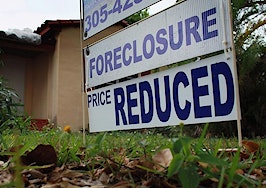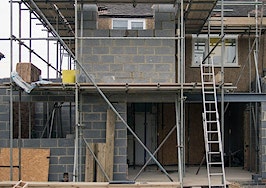It’s pretty simple, really. If people don’t move, our industries will be blown up — and the forecast for movers, buyers and sellers this winter looks terrible. This winter will forever change the face of real estate.
Today, it’s a seller’s market, and consumers have been devouring homes. Yet nationwide, sellers have been having cold feet about putting their home on the market for a variety of reasons. This is an ongoing trend that’s getting worse.
As recently as the year 2000, 15 percent of the population moved each year. Twenty years later, the percentage of movers has been reduced an astonishing 9.8 percent — and that was before COVID-19 came to town.
Concerns over COVID-19 placed the already cool housing supply into the icebox. So, just how cold is this real estate winter going to be, and what can we learn from the data to improve our future?

How is the market?
I spoke with my friend Mike Simonsen, CEO of Altos Research, as I was curious about the condition of the market. Altos does awesome reports on the strength and conditions of the market for your ZIP code, so he knows where we stand.
Mike shared with me that as of Friday, total single-family residential listings are down 41 percent year over year. A drop of this magnitude is an unheard-of, groundbreaking territory (currently, there are only 573,000 SFR active listings in the U.S.). This low inventory is cause for significant alarm.
What business model can sustain a reduction in supply of greater than 40 percent without serious disruption? I consulted with Roberto Cavazos, Ph.D., who is an economics professor and has worked for both the U.S. Department of Housing and Urban Development (HUD) and the Federal Housing Administration (FHA).
“Housing inventory is a problem, and financing is also a prob in many markets where prices are running away,” he said. “It’s a terribly stressed situation for those people.”
Surprisingly, home sales are on fire nationally, up 11 percent year over year. That hot market is causing a major smoke screen, keeping us from seeing the underlying problem. And the hot sales are a trend that illustrates there will be further depletion of the available housing stock (i.e., more people are buying up the remaining inventory).
Seasonally, we tend to see the number of listings, home sales and traffic on search sites wane at the end of summer. However, summer is over, and sales momentum and search traffic has not yet started to slow, indicating stronger-than-normal demand.
Very high demand
Realtor.com posted astonishingly high record traffic numbers in July. RDC’s Marci James shared with me that 92 million unique potential movers searched frivolously for their next home. This is a quantum leap up 26 percent from last year then record-setting numbers and just an astonishingly high amount of demand.
Realtor.com also reports that nationally, average days on market is down 18 percent year over year nationally to 54 days. Average price has increased 11 percent year over year to $350,000. As a homeowner, that’s exciting — but as an industry, we ought to be concerned.
If current trends persist, we can imagine there won’t be enough housing stock to go around. Loan originators and Realtors will be fighting for seller leads in the streets. In the near future (winter 2020 or 2021), it’s likely that agents will be looking for work elsewhere, while loan originators hang on to a more-than-solid refi market.
Real estate (problems) are local
As you may guess, it’s not the same everywhere. According to Cavazos, “This [supply issue] is not so much an issue in Dallas Fort Worth, but it’s a huge issue in many parts of California. So it’s very market by market.”
“Currently, we are seeing significant internal migration,” he continued. “It might be another 12 months where people are exiting major metro areas, leaving behind lots of inventory, and in the other places the production housing people ought to see the opportunity. There is demand — it’s a matter of how quickly the production housing people can turn it on.”
If you build it, they will come
How do we begin to satisfy this immense demand in a record-setting housing shortage? The obvious solution is to build more supply or find more sellers. The U.S. needs a building spree the likes of which we’ve not seen since after WWII.
In 2019, 1.29 million housing units were started in 2019, up 3.2 percent compared to 2018. According a September report by the U.S. Census Bureau and HUD, single-family housing starts in August were at a rate of 1.036 million. Yet, here we sit, lacking supply and runaway rising cost — especially for starter homes.
Facing rising prices and a lack of inventory, Tokyo was forced to take drastic measures in the last 20 years. With great success, they were able to influence price stabilization and increase supply.
Growth of rent
Renting is by far outpacing homeownership in growth recently. On average, two-thirds of households are owned, while one-third are rentals nationwide. However, increasingly, some cities are seeing rent explode and have greater than 50 percent of households as renters.

Affordability of housing is key. Relative to earnings, the cost of rent is lower than that of buying. Rent is on the increase nationally 36 percent over 10 years (or 3.6 percent year-over-year average).
This year, it’s not keeping pace, with the 11 percent year-over-year increase in the cost of buying due to demand-driven property value increase. Buying is becoming even more unaffordable for first-time buyers.
This is despite the record-low mortgage rates. And, in case you missed it, those low rates will remain for some time as the Fed announced last week that they will likely keep rates low until 2023. Unlike the 1980s and ’90s, mortgage rates are not prohibiting the American Dream — purchase price is.
First-time homeowners
Millennial first-time homebuyers continue to be perceived as if they are an untapped reserve of buyers, and this could further exacerbate our supply situation. So just how many buyers are in that segment?
According to Apartment List, currently, the millennial homeownership rate has grown to 43 percent, still well below the rates of Generation X (67 percent) and the baby boomer and silent generations (77 percent). This population is craving additional supply and lower price ranges.

In 2019, there were 128.58 million households in the U.S. So, while the percentage of movers is dropping, there were an additional 7.6 million new households created over the past decade, and that may seem like a lot at first glance. However, 760,000 households coming online each year is only half of 1 percent of the total households in the U.S.
Making matters worse, barely any of those new households were owner-occupied. In the same time period, renter new households increased 10 percent. Now more than ever, new households are opting to rent, rather than buy. This trend pushes down the number of mortgages and sales that are available for the industry.
First-time homebuyers don’t have anything to sell. They are part of the “supply problem” as collectively, they represent a net loss of supply.
When is the crash?
But what of the pending crash due to a flood of forbearance and foreclosures? Won’t this overwhelm the market with supply like we saw from 2007 t0 2010? Not according to Mike Simonsen.
On his monthly report yesterday, Simonsen clearly showed that unlike the highly leveraged, high loan-to-value (LTV) housing market of the time, where people had loans that went quickly underwater as the market turned, this time, it’s different. In 2020, LTV ratios are much better — with billions of dollars of equity that will prevent people from walking away from their homes.
According to Mortgage Orb, 6.87 percent of mortgages were in forbearance as of Sept. 20. That’s 3.4 million loans, down from 4.3 million (or 8.55 percent) as of June 7. The article states that “since the MBA started publishing data on homeowner exits from forbearance in early May, a large percentage of exits have been attributed to homeowners who went into forbearance but never stopped paying their mortgage.”
People don’t want to be forced to move. Even with a devaluation of 10 percent, people will still have equity. They will negotiate with their banks to keep the home rather than walk away as they did during the Great Recession. Thankfully, we won’t get enough supply from foreclosures.
We are bloated
According to NAR, there are over 2 million active real estate agents in the U.S., and typically, they do 5.5 million transactions per year. If supply continues to be 40 percent below normal, or if it drops even further, there will have to be adjustments that will be proportionate to the workforce.
So, at this point, winter looks pretty tough. The outlook is bleak. There will be significant reduction of agents and consolidation of real estate companies in markets that will be depressed due to the migration.
Cavazos agreed, saying: “We don’t need nearly as many real estate agents to facilitate the projected number of transactions in those markets. There’s practically going to be one person in Toledo doing all the purchases in NW Ohio.”
It’s not just real estate and mortgage companies. Home improvement stores, consumer package goods, cable and satellite carriers, mattress and furniture companies — they are all focused on movers, and they all are built up to service the 5.5 million annual home sales.
If no one is willing or desires to list their home, and there is not enough new construction, all these industries will be severely impacted by a lack of movers.
Blown up
Today, the market remains red hot as summer, and unfortunately, many of the people in the industry are celebrating, oblivious to the fact that they are standing in the dry arid desert on ground zero as the supply bomb has already been dropped.
If there are no listings, the real estate machine will face a melt down. Transaction volumes will plummet, agents will look for reliable work elsewhere. Companies will crumble and consolidate.
Some will see chaos as an opportunity. Now is the time to make moves, to pivot and to innovate. This winter will be very tough. An entirely different and very cold reality faces us. This is the winter that will forever change the face of real estate.
Chris Drayer is the co-founder of Revaluate. Connect with him on LinkedIn and on Twitter @FPO.













